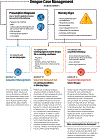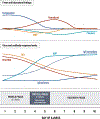Dengue
- PMID: 38280388
- PMCID: PMC12372472
- DOI: 10.1016/S0140-6736(23)02576-X
Dengue
Abstract
Dengue, caused by four closely related viruses, is a growing global public health concern, with outbreaks capable of overwhelming health-care systems and disrupting economies. Dengue is endemic in more than 100 countries across tropical and subtropical regions worldwide, and the expanding range of the mosquito vector, affected in part by climate change, increases risk in new areas such as Spain, Portugal, and the southern USA, while emerging evidence points to silent epidemics in Africa. Substantial advances in our understanding of the virus, immune responses, and disease progression have been made within the past decade. Novel interventions have emerged, including partially effective vaccines and innovative mosquito control strategies, although a reliable immune correlate of protection remains a challenge for the assessment of vaccines. These developments mark the beginning of a new era in dengue prevention and control, offering promise in addressing this pressing global health issue.
Copyright © 2024 Elsevier Ltd. All rights reserved.
Conflict of interest statement
Declaration of interests No funding was used for this publication. GP-B and LEA are employees of the Centers for Disease Control and Prevention. LCK is supported by the Intramural Research Program of the US National Institute of Allergy and Infectious Diseases. The findings and conclusions in this Seminar are those of the authors and do not necessarily represent the official position of the US Centers for Disease Control and Prevention. All other authors declare no competing interests.
Figures




References
-
- Rigau-Perez JG, Clark GG, Gubler DJ, Reiter P, Sanders EJ, Vorndam AV. Dengue and dengue haemorrhagic fever. Lancet. 1998;352(9132):971–7. - PubMed
-
- Nature Education. Dengue viruses Cambridge, MA: Nature Education; 2014. [Available from: https://www.nature.com/scitable/topicpage/dengue-viruses-22400925/.
-
- Cattarino L, Rodriguez-Barraquer I, Imai N, Cummings DAT, Ferguson NM. Mapping global variation in dengue transmission intensity. Sci Transl Med. 2020;12(528). - PubMed
Publication types
MeSH terms
Substances
Grants and funding
LinkOut - more resources
Full Text Sources
Medical
Miscellaneous

